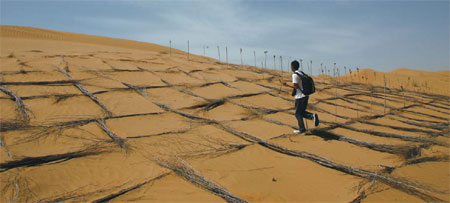Inner Mongolia to assist in fight against Beijing sandstorms
Updated: 2013-03-14 07:03
By Chen Jia (China Daily)
|
||||||||
|
A volunteer with an environmental NGO walks on a desert as part of a desertification project in Dalad Banner, the Inner Mongolia autonomous region, in May 2012. Zhang Fan / Xinhua |
Deputies from the Inner Mongolia autonomous region to the 12th National People's Congress, China's top legislature, have called for upgrading the desertification control project that blocks sandstorms from hitting the country's capital, a measure that gives environmental protection the same weight as economic development.
The Xilingol League plans to start the second stage of the Sandstorm Source Control Project around Beijing and Tianjin this year, investing 6 billion yuan ($952 million) to change 2.67 million hectares of sand into grassland, said Liu Junchen, leader of the Xilingol League and an NPC deputy.
The Xilingol Grassland, 180 km from Beijing, is the nearest grassland to the capital and Tianjin.
"The overall ecological degradation has been initially curbed," Liu said.
The vegetation coverage in the league's grassland reached 60 percent at the end of 2012, up from 23 percent in 2000, Liu said.
The first stage of the Sandstorm Source Control Project around Beijing and Tianjin was finished in Xilingol League last year. The league recovered 2.17 million hectares of grassland during the past 10 years and planted more than 800 km of protection forest, a report from the local government said.
Bater, chairman of the Inner Mongolia autonomous region, said a key task for the local government in the past five years has been balancing environmental protection and resource development.
"The exploitation of resources, especially the development of coal mines, has been the main driving force to support the fast growth of Inner Mongolia in recent years," Bater said.
"It also contributes to high local fiscal growth, which is the precondition to launching large environmental protection projects."
He suggested taking a "balanced" measure and improving production technology to develop modern industries.
In his annual Government Work Report to NPC deputies, Premier Wen Jiabao highlighted that economic development is increasingly in conflict with resource conservation and environmental protection.
"We should adopt effective measures to prevent and control pollution and change the way we work and live," he said.
One key to improving the living environment is to speed up the adjustment of the economic structure and distribution, as well as upgrading related regulations and laws, Wen suggested in the report.
Ecological damage in the Xilingol Grassland is still very grim, and the trend of increasing desertification has not yet been fully controlled, said Liu.
The task of grassland protection is now arduous, especially in the Hunshadake Sandy Land area, where wandering dunes cover about 667,000 hectares, about 11 percent of the sandy land, according to Liu.
chenjia1@chinadaily.com.cn
(China Daily 03/14/2013 page6)

 In Photos: 7.0-magnitude quake hits Sichuan
In Photos: 7.0-magnitude quake hits Sichuan
 Li Na on Time cover, makes influential 100 list
Li Na on Time cover, makes influential 100 list
 FBI releases photos of 2 Boston bombings suspects
FBI releases photos of 2 Boston bombings suspects
 World's wackiest hairstyles
World's wackiest hairstyles
 Sandstorms strike Northwest China
Sandstorms strike Northwest China
 Never-seen photos of Madonna on display
Never-seen photos of Madonna on display
 H7N9 outbreak linked to waterfowl migration
H7N9 outbreak linked to waterfowl migration
 Dozens feared dead in Texas plant blast
Dozens feared dead in Texas plant blast
Most Viewed
Editor's Picks

|

|

|

|

|

|
Today's Top News
Live report: 7.0-magnitude quake hits Sichuan, heavy casualties feared
Boston suspect cornered on boat
Cross-talk artist helps to spread the word
'Green' awareness levels drop in Beijing
Palace Museum spruces up
First couple on Time's list of most influential
H7N9 flu transmission studied
Trading channels 'need to broaden'
US Weekly

|

|








